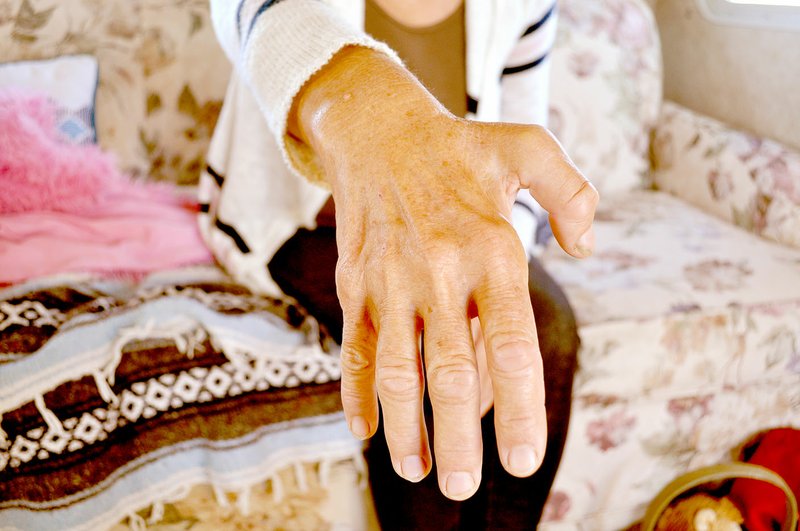Libby Bond of Longview struggles to overcome a rare inherited condition called Charcot-Marie-Tooth, or CMT.
Named for the three doctors who discovered it, it is a nerve disease that causes nerves to degenerate and muscles to atrophy.
Libby said that, when she was diagnosed in 1997, there were seven types of CMT. The last time she checked, there were 59 types because it mutates. One in 2,500 people have it, and most do not know they have it. CMT is the most common inherited neuropathy, but it is rare because people do not often get diagnosed properly, she said. People often instead get diagnosed with MS, muscular dystrophy, diabetes or a mild stroke, she said.
CMT starts in the peripheral nerves -- the hands and feet, Bond said.
She explained her history. When she was in the first grade she had trouble trying to hold a pencil properly, she said. The nerves that controlled the muscles in her fingers were not functioning properly, she explained.
She said she does a lot of adapting and has her own way of doing things. She has done so since an early age. Her thumbs are basically useless, she said, so she has to find other ways to use her hands.
On their second date, her husband, Mearle, said, "You don't walk right." The boys in high school had also teased her about the way she walked and she did not know why. She later realized her feet and lower leg muscles were imbalanced, so she would use her thighs to lift her feet so she would not trip over her own feet.
In her growing up years, her parents did notice a few things that were different, but the doctors always said she would outgrow it or that she was just clumsy.
She severely injured herself trying to ride a bicycle because balance is a big problem for people with CMT. She had tried and tried to ride a bicycle, and the last time she tried, the handlebar stuck in her throat and injured her vocal chords, rendering her unable to speak for a month. At that point, she gave up trying to ride a bicycle.
"My father had a saying, 'Can't never did anything until he tried.' So that's what kept me going in life," she said.
Another symptom is that, if she gets too warm, her arms and legs feel like there are ants biting her all over. She said it is very painful.
"My kids would play soccer, baseball, whatever, and I love to go. I learned to take ice packs. You learn to adapt and be more able than disabled. It's a lifelong process of learning to adapt," she said.
At age 40 she was working for Avon, had two children at home and was helping her husband with his business. She was vacuuming one day when her muscles locked up and she fell. She was in terrible pain. Her four-year-old son tried to help her up. She had him call his father, and he came home and took her to the chiropractor, who was some distance away.
Soon she started going to a chiropractor who was closer to home, who allowed Mearle to take home his physician's manual to look at symptoms to try to figure out what was wrong with Libby. Through some friends, Libby got connected with Dr. James Baker in Bella Vista, Ark., who did his internship at the Muscular Dystrophy Center in Tulsa. He ended up sending her to the Mayo Clinic, where she underwent three days of tests with 27 specialists. The leading doctor asked Mearle what he thought Libby had, and he said Charco-Marie-Tooth. The doctor came back three days later and said, "good diagnosis," Libby said.
"The lesson that I've learned from all that is to be your own advocate. The doctor can only know what you tell him," she said.
Libby said a lot of her problems are from damage she caused herself. If she had been diagnosed earlier, she would have known not to push herself so hard in certain cases. For example, she and Mearle hiked to the bottom of the Grand Canyon and back in 12 hours once.
"Someone in my condition, especially with that incline -- I should have never done it."
Also, she and Mearle had a commercial window cleaning business. She was carrying five-gallon buckets in cold temperatures and caused damage to her arms.
She has leg braces for walking. She did not want them at first, because she thought she had been walking fine for years. But then she got the braces and saw how easy walking was supposed to be, she said.
After being diagnosed, Libby had to give up her job. She started a support group right away, because a lot of things started making sense, she said. Both her father and paternal grandmother had CMT and were not diagnosed, she said.
"We drop things, we cut ourselves, we burn ourselves, we don't realize we've burned ourselves until we've already got the blisters. So we can be pretty dangerous in the kitchen. Everyone is affected in different ways. That's why it's so difficult to diagnose," she said.
Her youngest daughter also has CMT. She walked on her toes when she was learning to walk. That is one of the first signs of the disease, Libby said.
She said there is a lot of help available now, but not at the time when she was diagnosed.
"I lived for 40 years with an enemy that I did not know. How many people have lived not knowing? I feel like I've been a stronger person for it. Continually grieving a loss of something you can't do anymore and then a year later it's something else," she said.
"There are things that are not in our control, but it's what you do with it," she concluded.
General News on 12/05/2019
